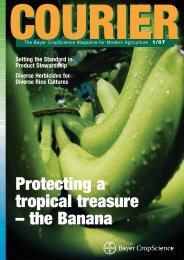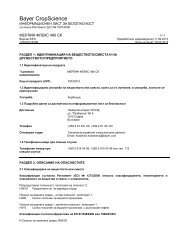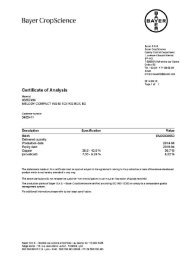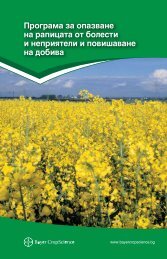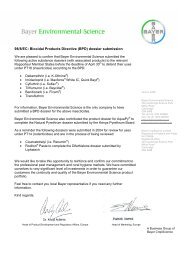For healthy potatoes - Bayer CropScience
For healthy potatoes - Bayer CropScience
For healthy potatoes - Bayer CropScience
Create successful ePaper yourself
Turn your PDF publications into a flip-book with our unique Google optimized e-Paper software.
Improved plant-health<br />
Continuous evaluation of field trials data<br />
indicated that applications of imidacloprid<br />
containing products like Confidor resulted<br />
in increased growth and higher yields even<br />
in the absence of damaging pest species.<br />
Analysis of the growing conditions given<br />
in these trials pointed to environmental<br />
stress factors being involved.<br />
To investigate how imidacloprid-treated<br />
plants do respond and adapt to abiotic<br />
stress conditions, drought stress tests e.g.<br />
with barley plants were developed to study<br />
growth compared to untreated droughtstressed<br />
plants.<br />
It could be shown that the leaf area of<br />
drought-stressed barley plants treated with<br />
imidacloprid increased compared to<br />
untreated plants. Subsequent gene analysis<br />
in barley revealed a delayed production of<br />
drought stress marker genes. Plants from<br />
Yield losses from biotic and abiotic stresses<br />
Yield (kg/ha)<br />
20,000<br />
16,000<br />
12,000<br />
8,000<br />
4,000<br />
0<br />
Corn Wheat Soybean Sorghum Oat Barley<br />
Source: Buchanan, Gruissem, Jones; Biochemistry and Molecular Biology of Plants;<br />
American Society of Plant Physiologists, 2000<br />
the same tests showed longer lasting<br />
energy production-related gene activity<br />
(photosynthesis), supporting plants with<br />
more energy during drought stress. Surprisingly,<br />
imidacloprid-treated barley<br />
plants also formed more plant own substances<br />
(pathogenesis-related proteins)<br />
associated with the plant’s own defense<br />
mechanism against fungal diseases. The<br />
above genetic findings are paralleled in<br />
further pest-free stress tests proving<br />
increased root development of tomato<br />
plants grown under low oxygen conditions,<br />
a situation which often occurs during infurrow<br />
irrigation or water-based (hydroponic)<br />
cultivation systems. Finally, it could<br />
be confirmed with a specific new laserlight<br />
camera that drought stressed cotton<br />
plants following seed treatment with imidacloprid<br />
used the sunlight for plant-own<br />
energy production (photosynthesis) more<br />
efficiently.<br />
Record yield<br />
(Highest yield<br />
ever achieved)<br />
Abiotic losses<br />
Biotic losses<br />
Average yield<br />
Imidacloprid significantly increased barley leaf growth under drought stress conditions<br />
[L*n]<br />
1000<br />
800<br />
600<br />
400<br />
L*n = Longest<br />
leaf x<br />
number of<br />
leaves<br />
treated<br />
untreated<br />
Drought period<br />
6-chloronicotinic acid (6-CNA) is suggested<br />
to possibly cause the physiological<br />
changes in the plant which aid in plant and<br />
stress protection. 6-CNA is a major<br />
decomposition product of imidacloprid in<br />
plant and a known inducer of the plantown<br />
defense against plant diseases.<br />
The interaction of imidacloprid with<br />
plants to moderate abiotic and biotic stress<br />
points to a 2nd mode of action on top of<br />
the well known direct mode of action<br />
against insect pests supporting plants to<br />
achieve higher yields and better quality<br />
under adverse growing conditions.<br />
Imidacloprid represents a new standard<br />
in abiotic plant stress research, validated<br />
both in lab- and field situations. Such a<br />
standard is a prerequisite in the search of<br />
new active ingredients with improved<br />
Stress Shield properties. Advances in<br />
Stress Shield technology combined with<br />
new stress-tolerant varieties will contribute<br />
to further reduce the risk of yield losses.<br />
Oil-based innovation<br />
The new OTEQ formulation, an oil dispersion<br />
(OD type), enhances the Stress Shield<br />
effect even further and <strong>Bayer</strong> <strong>CropScience</strong><br />
is committed to continued research to fully<br />
explore the potential benefits of Confidor.<br />
“<strong>Bayer</strong> <strong>CropScience</strong> is a very supportive<br />
and enthusiastic research partner,” says<br />
Prof. Derrick Oosterhuis, a leading cotton<br />
physiologist at the University of Arkansas.<br />
“Investment in innovation is clearly a priority<br />
and that shows through in products<br />
that are fully in line with market needs.”<br />
Confidor OTEQ formulations were<br />
launched in Portugal in 2006 and are due<br />
for roll-out in most major European countries<br />
in the next two years. Its initials stand<br />
for an oil based innovation which penetrates<br />
plants more effectively, spreads more<br />
efficiently and is more adhesive, so there’s<br />
no need to spray crops again after rainfall.<br />
Additionally, a faster onset of action is<br />
achieved, which allows more flexible timing<br />
of application. “The new OTEQ formulation<br />
confirms <strong>Bayer</strong> <strong>CropScience</strong>’s<br />
place at the cutting edge of technology,”<br />
says Christian Nagel, Global Product<br />
Manager CNI with <strong>Bayer</strong> <strong>CropScience</strong> in<br />
Monheim. ■<br />
200<br />
Christian Nagel,Dr. Wolfgang Thielert,<br />
<strong>Bayer</strong> <strong>CropScience</strong> AG, Germany<br />
0<br />
3 6 9 12 15 18 21 24 27 30 days<br />
Imidacloprid treatments (days)<br />
8 COURIER 2/06





